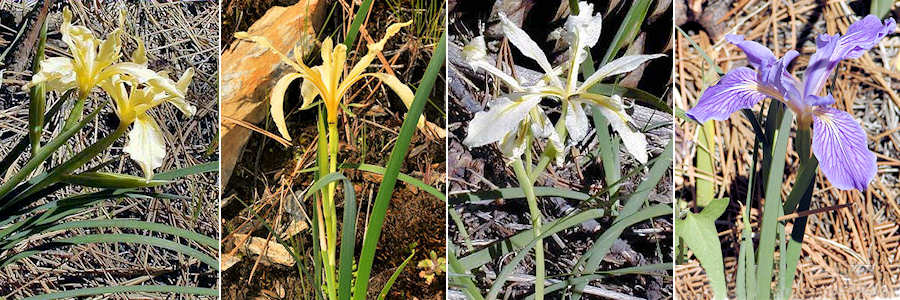Population Study of the Iris hartwegii Complex
By Erin Riggs
Portland State University
SIGNA, Spring 2003 No. 70, p.3561-3, 6 figs.
[Adapted and slightly modified for the web. Images substituted]
Victor Cohen wrote, "Would that one could love it!" while describing the gawky, ungainly little Iris hartwegii. This wild cousin of the more eye-catching garden iris has found a place in my heart. It is as sweet as a small ray of sun.
I started my botanical journey into the world of the Iris at the suggestion of Dr. Carol Wilson, my major professor at Portland State University. I was a graduate student with no project and she directed me to the Iris hartwegii complex. I decided look at the group with both morphological and molecular data, with the hopes of clarifying the taxonomic issues. Along the way, not only did I learn science, I discovered the beauty of the wild Iris.
The Iris hartwegii complex. The I. hartwegii complex, at this time, is comprised of four subspecies: 1) Iris hartwegii subsp. hartwegii Baker, 2) Iris hartwegii subsp. columbiana Lenz, 3) Iris hartwegii subsp. pinetorum Eastwood) Lenz, and 4) Iris hartwegii subsp. australis Parish) Lenz (Figures 1-4). Its members are mainly distributed in California's Sierra Nevada mountain range, with one subspecies, I. h. australis in the San Bernardino and San Gabriel mountains of southern California.

The Irus hartwegii complex: 1) I. h. hartwegii (Nevada County, Steve Ayala), 2) I. h. columbiana (Tuolumne County, Ron Parsons), 3) I. h. pinetorum (Plumas County, Steve Ayala), 4) I. h. australis (San Bernardino County, Richard Richards).
The complex is currently placed within the subgenus Limniris Tausch (the beardless irises), section Limniris Tausch, and series Californicae (Diels) Lawrence. This series is also known as the "Pacific Coast Irises".
Each member of the I. hartwegii complex has undergone various taxonomic revisions. In 1958 when Lenz reviewed the complex, he retained I. h. subsp. hartwegii as such, described I. h. subsp. columbiana as new, and included I. pinetorum (named as a distinct species by Eastwood in 1931) as another subspecies of I. hartwegii.
Iris hartwegii subsp. australis has had more changes than any other. Parish first described it in 1898 as a variety of I. hartwegii. In 1937, Foster described it a variety of I. tenax, and in 1958, Lenz listed it as a subspecies in the I. hartwegii complex.
Recently there has been a growing interest in the series Californicae. Young (1998) wrote that while based on molecules they all form one complex, they could still be considered as morphologically identifiable distinct species. Wilson (2003) was able to resolve several taxonomic relationships, with the exception of the I. hartwegii complex. She suggested, from molecular data, the Pacific Coast Iris form a polyphyletic group (a taxon that contains descendants of two or more ancestral sources), but from morphological data they may be paraphyletic (a taxon that contains some, but not all, descendants of the most recent common ancestor of that group).
The goal of my research was to clarify taxon boundaries within the Iris hartwegii complex, based on morphological and molecular variation among the subspecies populations.
Appearance. I took morphological measurements, in the field, of 14 different characters. The measurements were from 10 populations for a total of 105 individuals. I analyzed this data using SYSTAT, a statistical program that determines similarities.
The resulting phenogram (a taxonomic tree based on calculations of overall similarities) suggests that I. h. subsp. pinetorum is the least similar to any other member of this group. The subspecies columbiana, australis, and hartwegii were each clustered in distinct subgroups, but were similar enough to remain in one inclusive group (Figure 5).

DNA. Molecular data was collected via RAPDs (randomly amplified polymorphic DNA). This technique amplifies random regions of the genome, and results in various sized DNA segments that can be used to characterize individuals. The DNA is separated on a gel and stained so that it glows under UV light. The presence or absence of singular sized DNA segments on the gel can be included in a data set and analyzed. I used SYSTAT to examine the DNA data.
The resulting phenogram generally supports the morphological data. Iris hartwegii subsp. pinetorum was the most distinct group, and I. h. subsp. hartwegii and subsp. columbiana formed one group (Figure 6).
Conclusions. Both molecular and morphological data support I. h. subsp. pinetorum as a distinct species. It should be returned to species status, I. pinetorum, as Eastwood originally named it in 1931. Additionally, both molecular and morphological data support retaining I. h. subsp. australis and I. h. subsp. hartwegii within the I. hartwegii complex. Finally the molecular and morphological data support a revision of the status of I. h. subsp. columbiana as a variety in the I. harwegii complex. This results from the grouping of I. h. subsp. columbina and subsp. hartwegii together using molecular data and the separation of the two subspecies using morphological data. My conclusion is that molecular change and morphological change in I. h. subsp. columbiana are proceeding at different rates.
Literature Cited
- COHEN, V. A.1967. A Guide to the Pacific Coast Irises. British Iris Society. 40 pp.
- EASTWOOD, A. 1931. Iris pinetorum. Proc. California Academy of Sciences (ser. 4) 20:137.
- FOSTER, R. C. 1937. A cyto-taxonomic survey of the North American species of Iris. Contributions from the Gray Herbarium of Harvard University. No. CXIX.
- LENZ, L. 1958. A revision of the Pacific Coast Irises. Aliso 4(2): 1-72.
- WILSON, C. A. 1998. A cladistic analysis of Iris series Californicae using morphological data. Systematic Botany 23:73-88.
- WILSON, C. A. 2003. Pylogenetic relationships in Iris series Californicae based on ITS sequences of nuclear ribosomal DNA. Systematic Botany 28: 39-46.
- YOUNG, N. D. 1998. Pacific Coast Iris species delimitation using three species definitions: biological, phylogenetic and genealogical. Biological Journal of the Linnean Society. 63: 99-120.